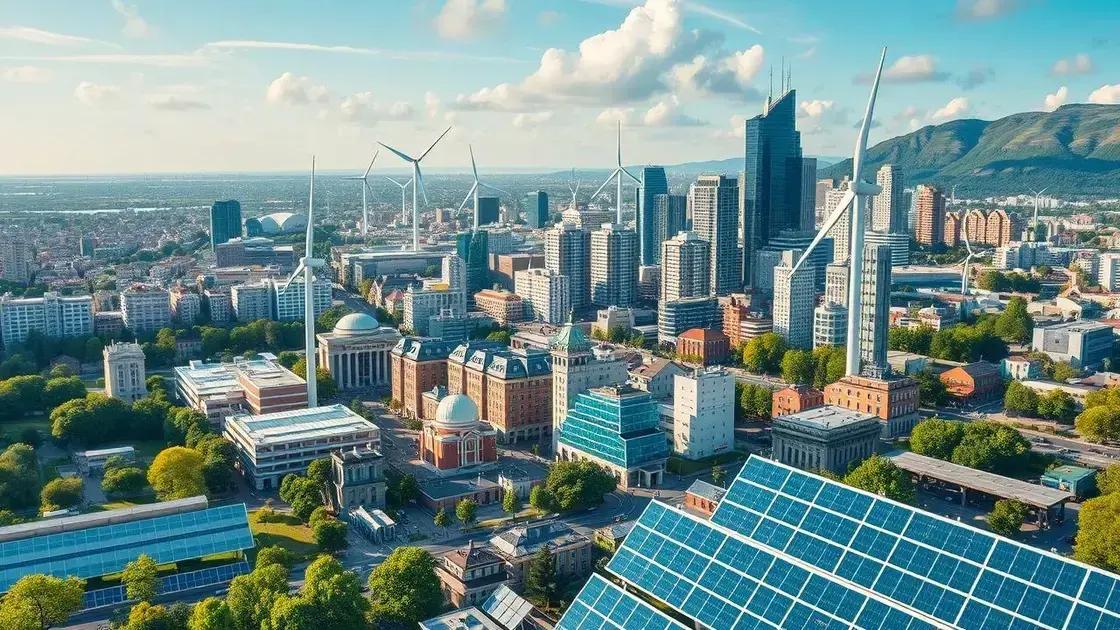Once energy policy discussion: shaping our future

Energy policies significantly impact environmental sustainability, economic growth, and community engagement, emphasizing the need for renewable energy integration and technology advancements to address future energy challenges effectively.
Once energy policy discussion plays a pivotal role in determining how nations approach sustainable energy solutions. Have you ever considered the long-term implications of these policies on our planet? Let’s dive in.
Understanding current energy policies
Understanding current energy policies is vital for grasping how they shape our energy landscape. These policies guide the production and consumption of energy, influencing everything from our utility bills to the health of our environment.
Energy policies often change due to new technologies and climate challenges. By staying informed about these changes, individuals and businesses can better adapt to new energy solutions and regulations.
Key Elements of Energy Policies
Several components make up effective energy policies. They include:
- Renewable Energy Standards: Policies that mandate a specific percentage of energy to come from renewable sources.
- Subsidies and Incentives: Financial aids for businesses and households to encourage the use of renewable energy.
- Efficiency Programs: Initiatives to enhance energy use in buildings, industries, and transportation.
Moreover, understanding the impact of energy policies on the environment is essential. For instance, transitioning towards cleaner energy mitigates greenhouse gas emissions and combat climate change. However, implementing these policies may present challenges as various stakeholders navigate economic, social, and technological factors.
The involvement of communities is critical. By engaging in public discussions, individuals can influence energy policies that directly affect their lives. It’s important for citizens to voice their opinions on energy issues to ensure that policies address local needs and environmental imperatives.
The Role of Stakeholders
Different groups play crucial roles in shaping energy policies. Governments, businesses, environmentalists, and the public all have interests that can conflict or align. Collaboration among these stakeholders can lead to innovative energy solutions that benefit everyone.
As the world grapples with climate emergencies and energy demands, understanding current energy policies becomes more significant than ever. It empowers individuals and communities to make informed decisions about energy consumption and advocates for impactful policy changes.
The impact of energy policies on the environment
The impact of energy policies on the environment is a crucial topic in today’s discussions about sustainability. When governments implement energy policies, they can either help protect the environment or inadvertently cause harm. Understanding this impact is essential for shaping future policies.
For instance, policies that promote renewable energy sources can significantly reduce greenhouse gas emissions. When countries invest in solar, wind, and hydroelectric power, they contribute to cleaner air and a healthier planet. These alternative energy sources generate power without the harmful emissions associated with fossil fuels.
Positive Environmental Impacts
Some positive effects of effective energy policies include:
- Reducing Carbon Emissions: Transitioning to clean energy lowers the amount of carbon dioxide released into the atmosphere.
- Conserving Natural Resources: Better policies can lead to more efficient energy use, leaving natural resources like coal and oil for future generations.
- Enhancing Air Quality: Decreasing reliance on fossil fuels leads to fewer pollutants in the air, improving public health.
On the other hand, poorly designed energy policies can have negative consequences. For example, a lack of regulation on fossil fuel extraction can result in habitat destruction and water pollution. In some cases, energy policies that favor non-renewable energy sources may hinder progress towards sustainability and exacerbate climate change.
Moreover, the long-term effects of energy policies can vary. While short-term benefits might be attractive, it’s the long-term sustainability that needs consistent evaluation. As society moves towards a greener future, energy policies must be adaptable to changing technologies and environmental conditions.
The Role of Public Awareness
Public awareness about the significance of energy policies is vital. When communities understand how these policies affect their environment, they can advocate for changes that will benefit both people and nature. Engaging in community discussions and encouraging transparency in government commitments are key actions everyone can participate in.
In sum, the impact of energy policies on the environment is complex. It requires careful consideration of both immediate benefits and long-term sustainability. Advocating for effective policies that promote clean energy and protect our planet is essential for a healthier future.
How energy policies affect economic growth

How energy policies affect economic growth is a critical question in today’s world. Energy policies can shape the overall health of an economy by influencing energy prices, job creation, and investment in technology. Understanding this relationship helps policymakers design better strategies for sustainable development.
When energy policies promote renewable energy sources, they can lead to significant economic benefits. These policies often create new industries and jobs, contributing to overall economic expansion. For example, the solar and wind sectors have experienced rapid growth, generating thousands of jobs in manufacturing, installation, and maintenance.
Components of Economic Growth
The key ways that energy policies impact economic growth include:
- Job Creation: New energy projects often require a skilled workforce, leading to increased employment opportunities.
- Investment Attraction: Clear and supportive energy policies can attract domestic and foreign investments in energy technologies.
- Infrastructure Development: Investing in renewable energy infrastructure can stimulate local economies and improve public services.
Moreover, stable energy prices supported by comprehensive policies can enhance economic stability. When energy prices fluctuate significantly, it creates uncertainty, which can hinder business planning and growth. Reliable energy policies help stabilize these prices, fostering an environment where businesses can thrive.
Challenges to Economic Growth
However, there are challenges that can impede economic growth. Poorly designed energy policies may lead to high costs for consumers and businesses. For instance, excessive regulations can stifle innovation and increase operational expenses. Furthermore, if policies favor certain energy sources without a balanced approach, it can create market distortions that may negatively affect economic growth.
The interplay of energy policies and economic growth is complex. Policymakers must consider various factors, including environmental sustainability, technological advancements, and social equity, when crafting energy policies. This comprehensive approach ensures that energy policies do not just promote growth but also protect the planet for future generations.
Challenges in formulating energy policies
Challenges in formulating energy policies can significantly affect their effectiveness and implementation. Policymakers face various obstacles that can make it difficult to create policies that meet all stakeholders’ needs. Recognizing these challenges is crucial for developing effective energy solutions.
One major challenge is balancing economic growth with environmental sustainability. Often, policies aimed at reducing emissions may come with high initial costs. These costs can discourage investment in renewable energy sources, especially in regions heavily reliant on fossil fuels. As a result, finding the right mix of energy sources is vital.
Key Challenges in Energy Policy Formation
Some of the critical challenges include:
- Political Influences: Energy policies often get affected by political agendas, which can lead to inconsistency and short-term thinking.
- Public Resistance: Communities may oppose changes to energy practices due to fears about job losses or the unfamiliarity of new technologies.
- Technological Limitations: Sometimes the technology for cleaner energy sources is still in development or not advanced enough to meet energy demands.
- Economic Factors: Market volatility and competition from lower-cost energy sources can hinder the adoption of more sustainable practices.
Moreover, data availability can pose a challenge. Policymakers need reliable data to understand energy needs and the impact of different sources. Inaccurate or insufficient data can lead to misguided policies that fail to address the real energy issues at hand. This situation calls for ongoing research and the use of innovative technologies for data collection.
Engaging Stakeholders
Effectively engaging all stakeholders is another challenge in policy formulation. Different groups, such as businesses, environmentalists, and the public, often have conflicting interests. Policymakers must navigate these interests to create policies that are equitable and effective.
Lastly, the rapid pace of global change adds complexity to energy policy formulation. As climate conditions shift and technology rapidly evolves, energy policies must adapt quickly. This can overwhelm existing structures and lead to delays in policy implementation.
Future trends in energy policy discussions
Future trends in energy policy discussions are shaping how nations approach sustainability and energy management. As global concerns about climate change and energy security grow, these discussions are becoming more urgent and complex.
One significant trend is the increasing focus on decarbonization. Many countries are setting ambitious goals to reduce carbon emissions and transition to cleaner energy sources. This shift is driving policies that support renewable energy technologies like wind, solar, and hydroelectric power.
Key Trends in Energy Policy
Some of the most important trends include:
- Integration of Renewable Energy: Policies are promoting the integration of renewables into the energy grid to reduce dependence on fossil fuels.
- Energy Efficiency Standards: New regulations are focusing on improving energy efficiency in buildings and industries, helping to lower energy consumption.
- Electric Vehicle Adoption: Governments are encouraging electric vehicle use through incentives, which also impacts energy demand and infrastructure needs.
- Smart Grid Technologies: Investments in smart grid technologies are enabling better energy management and consumption transparency.
Moreover, there’s a growing emphasis on community involvement in energy policy development. Engaging the public in discussions about local energy issues helps create policies that reflect the needs and values of the community. This participatory approach can lead to more successful and accepted energy initiatives.
Global Cooperation
Collaboration among countries is also becoming increasingly important. Global agreements like the Paris Agreement encourage nations to work together towards common energy goals. This cooperation can foster knowledge sharing and enhance the implementation of best practices in energy management.
As technology continues to evolve, future energy policy discussions will likely adapt to include innovations such as energy storage solutions and advanced data analytics. These advancements can optimize energy use and enhance the reliability of energy supply.
In conclusion, the discussions on energy policies are vital for addressing future energy challenges. These policies impact not just the environment but also economic growth and social equity. By focusing on renewable energy, efficiency, and community involvement, we can shape policies that provide sustainable solutions. Global cooperation and technology will play key roles in these discussions, ensuring that we meet our energy needs while protecting our planet. Engaging in these conversations is essential for everyone, as energy policy affects us all and will continue to evolve in the coming years.
FAQ – Frequently Asked Questions about Energy Policies
How do energy policies impact the environment?
Energy policies can significantly influence environmental health by promoting the use of renewable energy sources and reducing greenhouse gas emissions.
What are some key trends in energy policy discussions?
Key trends include a focus on decarbonization, integration of renewable energy, and increasing community involvement in policy decisions.
How can community engagement improve energy policies?
Involving the community in discussions helps create policies that are better suited to local needs and garners greater public support.
What role does technology play in future energy policies?
Technology is crucial for advancing clean energy solutions and improving energy management practices in response to evolving challenges.





